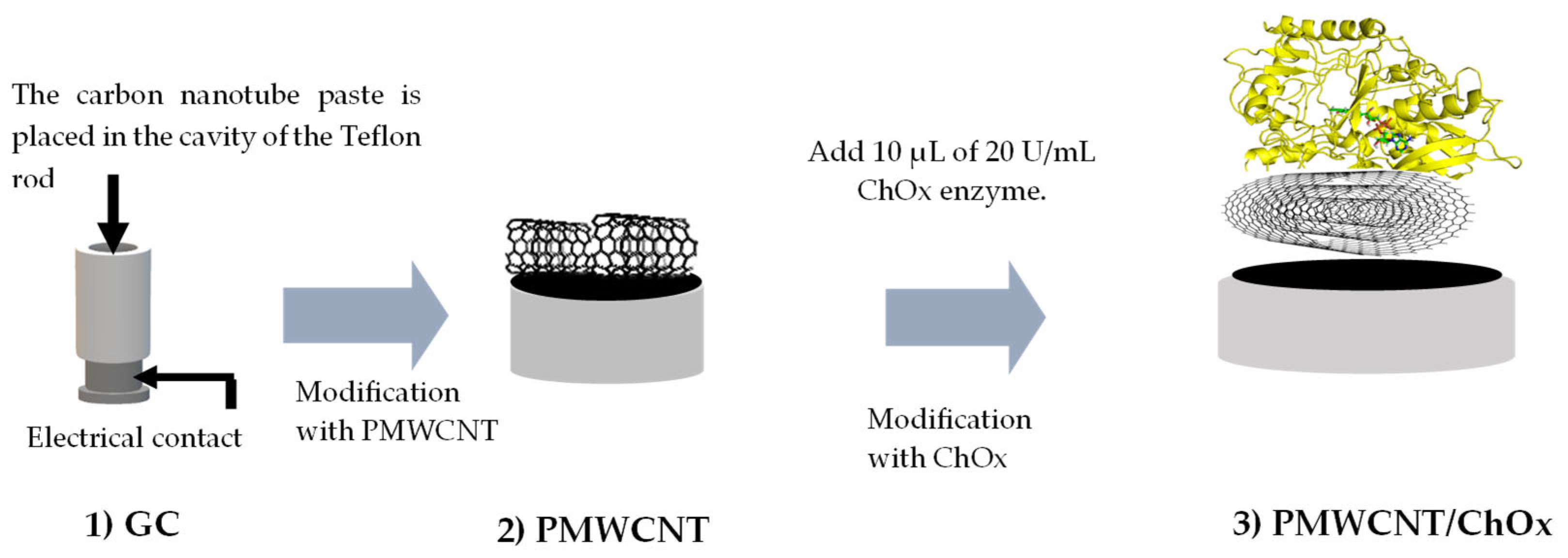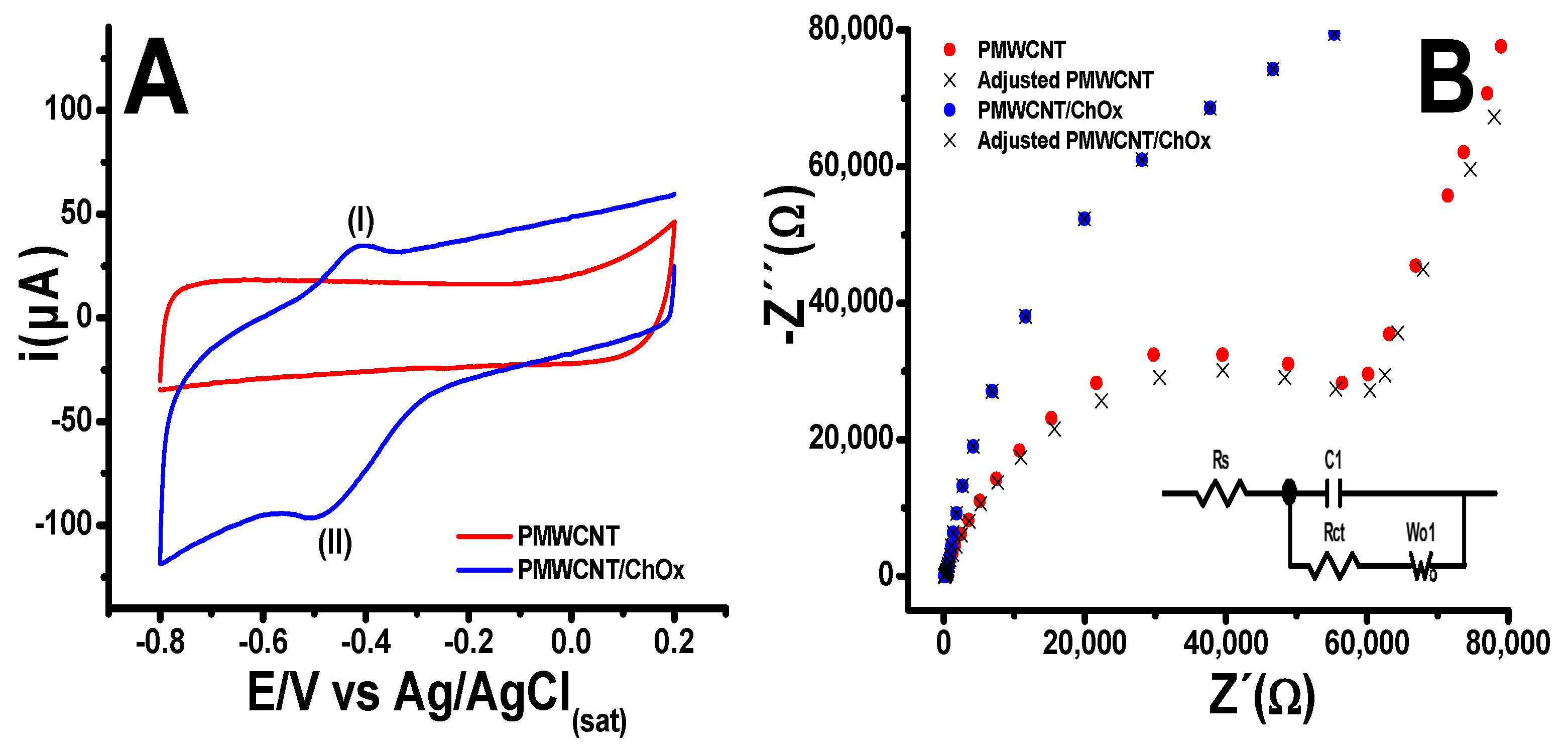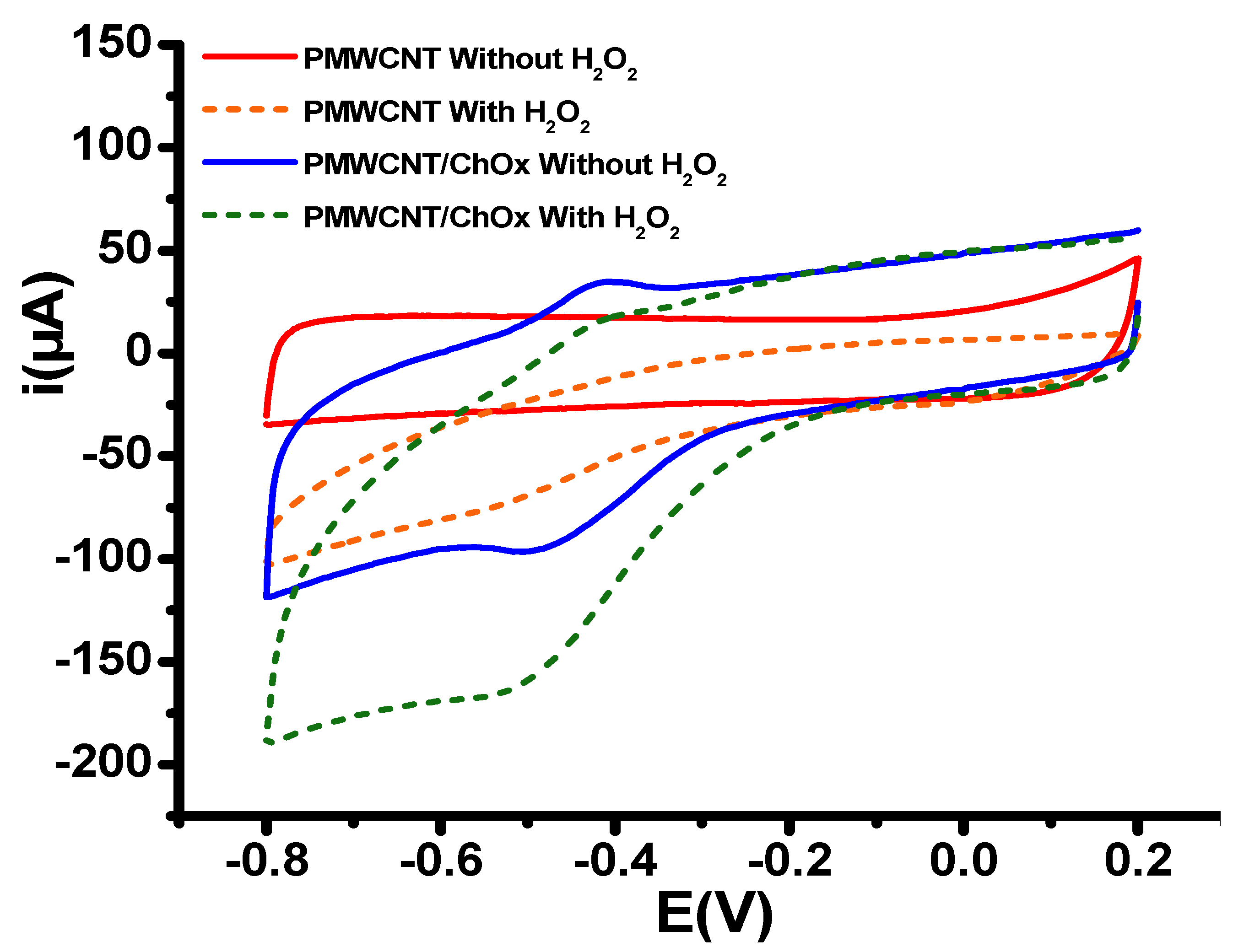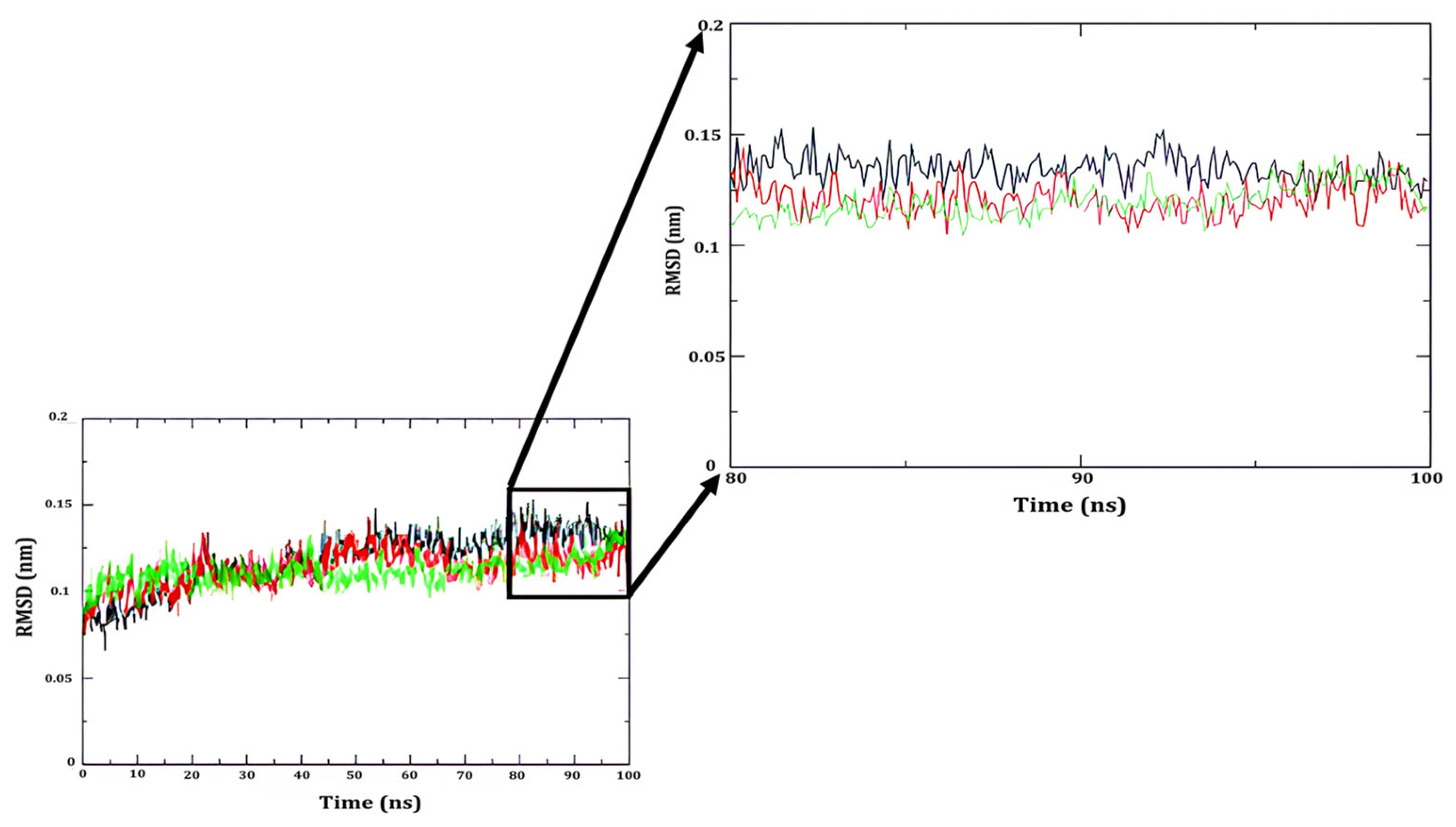Experimental and In Silico Studies on the Development of an Electrochemical Biosensor for the Quantification of H2O2 Based on the ChOx Enzyme
Abstract
1. Introduction
2. Materials and Methods
2.1. Reagents and Instruments
2.2. Software
2.3. Solutions
2.4. Sensing Bioplatform Preparation
2.5. Characterization of the Electrochemical Sensing Platforms
2.6. Electrochemical Quantification of H2O2
2.7. Molecular Dynamics Simulations of ChOx
2.8. Molecular Docking
2.9. Binding Energy Calculations Between ChOx and H2O2
3. Results
3.1. Electrochemical Characterization of the Sensing Platforms
3.2. Electrochemical Detection of Hydrogen Peroxide
3.3. Determination of H2O2 on the PMWCNT/ChOx
3.4. In Silico Studies: Interaction Between ChOx and H2O2
4. Discussion
5. Conclusions
Supplementary Materials
Author Contributions
Funding
Institutional Review Board Statement
Informed Consent Statement
Data Availability Statement
Acknowledgments
Conflicts of Interest
References
- Zhang, L.; Wang, Y.; Wang, Y.; Guo, M.; Li, Z.; Jin, X.; Du, H. Electrochemical H2O2 sensor based on a Au nanoflower-graphene composite for anticancer drug evaluation. Talanta 2023, 261, 124600. [Google Scholar] [CrossRef] [PubMed]
- Lyu, Q.; Zhai, Q.; Dyson, J.; Gong, S.; Zhao, Y.; Ling, Y.; Chandrasekaran, R.; Dong, D.; Cheng, W. Real-Time and In-Situ Monitoring od H2O2 Release from Living Cells by a Stetchable Electrochemical Biosensor Based on Vertically Aligned Gold Nanowires. Anal. Chem. 2019, 91, 13521–13527. [Google Scholar] [CrossRef] [PubMed]
- Sohrabi, H.; Maleki, F.; Khaaki, P.; Kadhom, M.; Kudaibergenov, N.; Khataee, A. Elecrochemical-Based Sensing Platforms for Detection of Glucose and H2O2 by Porous Metal–Organic Frameworks: A Review of Status and Prospects. Biosensors 2023, 13, 347. [Google Scholar] [CrossRef] [PubMed]
- Fatima, B.; Hussain, D.; Bashir, S.; Hussain, H.T.; Aslam, R.; Nawaz, R.; Rashid, H.N.; Bashir, N.; Majeed, S.; Ashiq, M.N.; et al. Catalase immobiliszed antimone quantum dots used as an electrochemical biosensor for quantitative determination of H2O2 from CA-125 diagnosed ovarian cancer samples. Mater. Sci. Eng. C 2020, 117, 111296. [Google Scholar] [CrossRef]
- Yagati, A.K.; Choi, J.-W. Protein Based Electrochemical Biosensors for H2O2 Detection Towards Clinical Diagnostics. Electroanalysis 2014, 26, 1259–1276. [Google Scholar] [CrossRef]
- Villamizar, E.N.; Rios, C.A.; Castillo, J.J. A Hydrogen Peroxide Biosensor Based on the Immobilization of the Highly Stable Royal Palm Tree Peroxidase (Roystonea regia) with Chitosan and Glutaraldehyde on Screen-printed Graphene Electrodes. J. Mex. Chem. Soc. 2016, 60, 135–140. [Google Scholar] [CrossRef]
- Vasconcelos, H.; Matias, A.; Mendes, J.; Araújo, J.; Dias, B.; Jorge, P.A.S.; Saraiva, C.; de Almeida, J.M.M.M.; Coelho, L.C.C. Compact biosensor system for the quantification of hydrogen peroxide in milk. Talanta 2023, 253, 124062. [Google Scholar] [CrossRef]
- Shi, L.; Liu, X.; Niu, W.; Li, H.; Han, S.; Chen, J.; Xu, G. Hydrogen peroxide biosensor based on direct electrochemistry of soybean peroxidase immobilized on single walled carbon nanohorn modified electrode. Biosens. Bioelectron. 2009, 24, 1159–1163. [Google Scholar] [CrossRef]
- Alvarez-Paguay, J.; Fernández, L.; Bolaños-Méndez, D.; González, G.; Espinoza-Montero, P.J. Evaluation of an electrochemical biosensor based on carbon nanotubes, hydroxyapatite and and horseradish peroxidase for the detection of hydrogen peroxide. Sens. Bio-Sens. Res. 2022, 37, 100514. [Google Scholar] [CrossRef]
- Tantawi, O.; Baalbaki, A.; El Asmar, R.; Ghauch, A. A rapid and economical method for the quantification of hydrogen peroxyde (H2O2) using a modified HPLC apparatus. Sci. Total Environ. 2019, 654, 107–117. [Google Scholar] [CrossRef]
- Sobhanie, E.; Hosseini, M.; Faridbod, F.; Ganjali, M.R. Sensitive detection of H2O2 released from cancer cells with electrochemiluminescence sensor based on electrochemically prepared polypyrrole@Ce: Dy tungstate7polyluminol. J. Electroanal. Chem. 2021, 932, 117244. [Google Scholar] [CrossRef]
- Gill, T.M.; Zheng, X. Comparing Methods for Electrochemically Accumulated H2O2. Chem. Mater. 2020, 32, 6285–6294. [Google Scholar] [CrossRef]
- Xu, Y.; Jin, X.; Khan, M.A.; Paiva-Santos, A.C.; Makvandi, P. Electroconductive bioplatform based on dextrin for the immobilization of hemoglobin: Application for electrochemical monitoring of H2O2. Environ. Res. 2023, 235, 116700. [Google Scholar] [CrossRef] [PubMed]
- Campus-Arias, L.; del Olmo, R.; Peřinka, N.; Casado, N.; Vilas-Vilela, J.L.; Mecerreyes, D.; del Campo, F.J.; Lanceros-Méndez, S. PEDOT:PSS-based screen-prentable inks for H2O2 electrochemical detection. Electrochim. Acta. 2023, 439, 141615. [Google Scholar] [CrossRef]
- Zhang, T.; Gu, Y.; Li, C.; Yan, X.; Liu, N.; Zhang, Z.; Zhang, H. Fabrication of Novel Electrochemical Biosensor Based on Graphene Nanohybrid to Detect H2O2 Released from Living Cells with Ultrahigh Performance. ACS Appl. Mater. Interfaces 2017, 9, 37991–37999. [Google Scholar] [CrossRef]
- Cao, Y.; Shi, H.; Zheng, Y.; Tan, Z.; Xie, Z.; Zhang, C.; Chen, Z. Polyaniline/prussian blue nanolayer enhanced electrochemical sensing of H2O2 in EBC using an integrated condensation facemask. Sens. Actuators B Chem. 2023, 393, 134189. [Google Scholar] [CrossRef]
- Harraz, D.M.; Weng, S.; Surendranath, Y. Electrochemically Quantifying Oxygen Reduction Selectivity in Nonaqueous Electrolytes. ACS Catal. 2023, 13, 1462–1469. [Google Scholar] [CrossRef]
- Teodoro, K.B.R.; Migliorini, F.L.; Christinelli, W.A.; Correa, D.S. Detection of hydrogen peroxide (H2O2) using a colorimetric sensor based on cellulose nanowhiskers and silver nanoparticles. Carbohydr. Polym. 2019, 212, 235–241. [Google Scholar] [CrossRef]
- Liu, X.; Feng, H.; Zhang, J.; Zhao, R.; Liu, X.; Wong, D.K.Y. Hydogen peroxide detection at a horseradish peroxidase biosensor with a Au nanoparticle-dotted titanate nanotubeǀhydrophobic ionic liquid scaffold. Biosens. Bioelectron. 2012, 31, 188–194. [Google Scholar] [CrossRef]
- Klun, U.; Zorko, D.; Stojanov, L.; Mirčeski, V.; Jovanoski, V. Amperometric sensor for gaseous H2O2 based on copper redox mediator incorporated electrolyte. Sens. Actuators Rep. 2023, 5, 100144. [Google Scholar] [CrossRef]
- Yin, H.; Zang, C.; Wang, Z.; Bai, X.; Yang, Z.; Liu, Z. A novel sensor based on P-Ru/NC for sensitive electrochemical detection of H2O2. J. Alloys Compd. 2023, 968, 171949. [Google Scholar] [CrossRef]
- Niu, B.; Wang, H.; Zhang, Y.; Nie, B.; Wang, H.; Lian, X.; Li, W. Green synthesis and characterization of Ag nanoparticles in phytic acid/ascorbic acid/sodium hydroxide system and their application in the lectrochemical detection of H2O2. New J. Chem. 2023, 47, 8797–8808. [Google Scholar] [CrossRef]
- Niyitanga, T.; Ahmad, K.; Chaudhary, A.; Kim, H. Carbon dots as efficient electrode material for hydrogen peroxide sensing applications: A mini review. Inorg. Chem. Commun. 2023, 156, 111249. [Google Scholar] [CrossRef]
- Eguilaz, M.; Venegas, C.J.; Gutiérrez, A.; Rivas, G.A.; Bollo, S. Carbon nanotubes non-covalently functionalized with cytochrome c: A new bioanalized with cytochrome c: A new bioanalytical platform for building bienzymatic biosensors. Microchem. J. 2016, 128, 161–165. [Google Scholar] [CrossRef]
- El-Gohary, A.R.M.; Galal, A.; Atta, N.F. CNTs/Graphene Oxide -Nickel Phosphate Nanocomposite-Based Electrochemical Sensors for Detecting H2O2 in Human Serum. ChemistrySelect 2023, 8, 3202301922. [Google Scholar] [CrossRef]
- Wang, X.; Dong, S.; Wei, H. Recent Advances on Nanozyme-based elecyrochemical Biosensors. Electroanalysis 2023, 35, 38–49. [Google Scholar] [CrossRef]
- Lozano, M.L.; Rodríguez, M.C.; Herrasti, P.; Galicia, L.; Rivas, G.A. Amperometric Response of Hydrogen Peroxide at Carbon Nanotubes Paste Electrode Modified with an Electrogenerated Poly(Fe(III)-5amino-phenantroline). Analytical Applications for Glucose Biosensing. Electroanalysis 2010, 22, 128–134. [Google Scholar] [CrossRef]
- Rivas, G.A.; Rubianes, M.D.; Rodrı, M.C.; Ferreyra, N.F.; Luque, G.L.; Pedano, M.L.; Miscoria, S.A.; Parrado, C. Carbon nanotubes for electrochemical biosensing. Talanta 2007, 74, 291–307. [Google Scholar] [CrossRef]
- Li, X.; Shi, F.; Wang, L.; Zhang, S.; Yan, L.; Zhang, X.; Sun, W. Electrochemical Biosensor Based on Horseradish Peroxidase and Blck Phosphorene Quantum Dot Modified Electrode. Molecules 2023, 28, 6151. [Google Scholar] [CrossRef]
- Lee, M.-J.; Song, J.-A.; Choi, J.-H.; Shin, J.-H.; Myeong, J.-W.; Lee, K.-P.; Kim, T.; Park, K.-E.; Oh, B.-K. Horseradish Peroxidase-Encapsulated Fluorescent Bio-Nanoparticle for Ultra-Sensitive and Easy Detection of Hydrogen Peroxide. Biosensors 2023, 13, 289. [Google Scholar] [CrossRef]
- Shin, J.-H.; Lee, M.-J.; Choi, J.-H.; Song, J.-E.; Kim, T.-H.; Oh, B.-K. Electrochemical H2O2 biosensor based on horseradish peroxidase encapsulated protein nanoparticle with reduced graphene oxide-modified gold electrode. Nano Coverg. 2020, 7, 39. [Google Scholar] [CrossRef] [PubMed]
- Wang, Q.; Xue, R.; Guo, H.; Wei, Y.; Yang, W. A facil horseradish peroxidase electrochemical biosensor with surface molecular imprinting based on polyaniline nanotubes. J. Electroanal. Chem. 2018, 817, 184–194. [Google Scholar] [CrossRef]
- Bhapkar, S.; Choudhari, U.; Jadhav, U.; Jagtap, S. Evaluation of soybean peroxidase-Cooper phosphate mediated organic-inorganic hybrid for hydrogen peroxide biosensor application. Sens. Int. 2023, 4, 100242. [Google Scholar] [CrossRef]
- Sheikholeslam, M.; Nanda, P.; Sanati, A.; Pritzker, M.; Chen, P. Direct electrochemistry of hemoglobin/peptide-carbon nanotube modified electrode for hydrogen peroxyde biosensing. Mater. Lett. 2023, 335, 133799. [Google Scholar] [CrossRef]
- Sun, M.; Shen, G.; Bai, Z.; Zhang, H.; Liu, H.; Liang, X. Electrochemical Determination of Hydrogen Peroxide Using a Horseradish Peroxidase (HRP) Modified Gold-Nickel Alloy Nanoparticles Glassy Carbon Electrode (GCE). Anal. Lett. 2021, 54, 2565–2573. [Google Scholar] [CrossRef]
- Ahammad, A.J.S. Hydrogen Peroxide Biosensor Based on Horseradish Peroxide and Hemoglobin. J. Biosens. Bioelectron. 2013, 9, 2–11. [Google Scholar] [CrossRef]
- Juska, V.B.; Pemble, M.E. A Critical Review of Electrochemical Glucose Sensing: Evolution of Biosensor Platforms Based on Advanced Nanosystems. Sensors 2020, 20, 6013. [Google Scholar] [CrossRef]
- Pohanka, M. Glucose electrochemical biosensors: The past and current trends. Int. J. Electrochem. Sci. 2021, 16, 210719. [Google Scholar] [CrossRef]
- Garcia-Morales, R.; Zarate-Romero, A.; Wang, J.; Vazquez-Duhalt, R. Bioengineered Lactate Oxidase Mutants for Enhanced Electrochemical Performance at Acidic pH. ChemElectroChem 2023, 10, e202300296. [Google Scholar] [CrossRef]
- Rathee, K.; Dhull, V.; Dhull, R.; Singh, S. Biosensors based on electrochemical lactate detection: A comprehensive review. Biochem. Biophys. 2016, 5, 33–54. [Google Scholar] [CrossRef]
- Lin, Y.; Yang, L.; Ma, Y.; Ye, J. Construction of minitype glutamate sensor for in vivo monitoring of L-glutamate in plant. Microchem. J. 2023, 188, 108505. [Google Scholar] [CrossRef]
- Windmiller, J.R.; Valdés-Ramírez, G.; Zhuo, N.; Zhuo, M.; Miller, P.R.; Jin, C.; Brozik, S.M.; Polsky, R.; Katz, E.; Narayan, R.; et al. Bicomponent Microneedle Array Biosensor for Minimally-Invasive Glutamate Monitoring. Electroanalysis 2011, 23, 2302–2309. [Google Scholar] [CrossRef]
- Campbell, A.S.; Kim, J.; Wang, J. Wearable electrochemical alcohol biosensors. Curr. Opin. Electrochem. 2018, 10, 126–135. [Google Scholar] [CrossRef] [PubMed]
- Azevedo, A.M.; Prazeres, D.M.F.; Cabral, J.M.S.; Fonseca, L.P. Ethanol biosensors based on alcohol oxidase. Biosens. Bioelectron. 2005, 21, 235–247. [Google Scholar] [CrossRef] [PubMed]
- Devi, S.; Kanwar, S.S. Cholesterol Oxidase: Source, Properties and Applications. Insights Enzym. Res. 2017, 1, 1–5. [Google Scholar] [CrossRef]
- Kumari, L.; Kanwar, S.S. Cholesterol Oxidase and Its Applications. J. Adv. Microbiol. 2012, 2, 49–65. [Google Scholar] [CrossRef]
- Vrielink, A.; Ghisla, S. Cholesterol Oxidase: Biochemistry and structural features. FEBS J. 2009, 276, 6826–6843. [Google Scholar] [CrossRef]
- Kakhki, S.; Bersan, M.M.; Shams, E.; Brett, C.M.A. New redox and conducting polymer modified electrodes for cholesterol biosensing. Anal. Methods 2013, 5, 1199. [Google Scholar] [CrossRef]
- CHARMM: Home. Available online: https://www.charmm.org/ (accessed on 15 October 2023).
- Sunhwan, J.; Lim, J.B.; Klauda, J.B.; Im, W. CHARMM-GUI Membrane Builder for Mixed Bilayers and Its Application to Yeast Membranes. Biophys. J. 2009, 97, 50–58. [Google Scholar] [CrossRef]
- Lee, J.M.; Cheng, X.; Swails, J.M.; Yeom, M.S.; Eastman, P.K.; Lemkul, J.A.; Wei, S. CHARMM-GUI Input Generator for NAMD, GROMACS, AMBER, OpenMM, and CHARMM/OpenMM Simulations Using the CHARMM36 Additive Force Field. J.Chem. Theory Comput. 2016, 12, 405–413. [Google Scholar] [CrossRef]
- Wu, E.L.; Cheng, X.; Jo, S.; Rui, H.; Song, K.C.; Dávila, E.M.; Qi, Y.; Lee, Y.; Monje-Galvan, V.; Venable, R.M.; et al. CHARMM-GUI Membrane Builder toward Realistic Biological Membrane Simulations. J. Comput. Chem. 2014, 35, 1997–2004. [Google Scholar] [CrossRef] [PubMed]
- Lyubimov, A.Y.; Lario, P.I.; Moustafa, I.; Vrielink, A. Atomic resolution crystallography reveals how changes in pH shape the protein microenvironment. Nat. Chem. Biol. 2006, 2, 259–264. [Google Scholar] [CrossRef] [PubMed]
- Jo, S.; Kim, T.; Iyer, V.G.; Im, W. CHARMM-GUI: A web-based graphical user interface for CHARMM. J. Comput. Chem. 2008, 29, 1859–1865. [Google Scholar] [CrossRef]
- Abraham, M.J.; Murtola, T.; Schulz, R.; Páll, S.; Smith, J.C.; Hess, B.; Lindahl, E. GROMACS: High performance molecular simulations through multi-level parallelism from laptops to supercomputers. SoftwareX 2015, 1, 19–25. [Google Scholar] [CrossRef]
- Bekker, H.; Berendsen, H.; Dijkstra, E.; Achterop, S.; Vondrumen, R.; Vanderspoel, D.; Sijbers, A.; Keegstra, H.; Renardus, M. Gromacs—A Parallel Computer for Moleciular—Dynamics Simulations. In Proceedings of the 4th International Conference on Computational Physics (PC 92), Physics Computing ’92, Prague, Czech Republic, 24–28 August 1992; pp. 252–256. [Google Scholar]
- Spoel, D.V.D.; Lindahl, E.; Hess, B.; Groenhof, G.; Mark, A.E.; Berendsen, H.J.C. GROMACS: Fast, flexible, and free. J. Comput. Chem. 2005, 26, 1701–1718. [Google Scholar] [CrossRef]
- Huang, J.; Rauscher, S.; Nawrocki, G.; Ran, T.; Feig, M.; de Groot, B.L.; Grubmüller, H.; MacKerell, A.D. CHARMM36m: An improved force field for folded and intrinsically disordered proteins. Nat. Methods 2017, 14, 71–73. [Google Scholar] [CrossRef]
- Huang, J.; MacKerell, A.D. CHARMM36 all-atom additive protein force field: Validation based on comparison to NMR data. J. Comput. Chem. 2013, 34, 2135–2145. [Google Scholar] [CrossRef]
- Lario, P.I.; Sampson, N.; Vrielink, A. Sub-Atomic Resolution Crystal Structure of Cholesterol Oxidase: What Atomic Resolution Crystallography Reveals about Enzyme Mechanism and the Role of the FAD Cofactor in Redox Activity. J. Mol. Biol. 2003, 326, 1635–1650. [Google Scholar] [CrossRef]
- Eberhardt, J.; Santos, D.; Tillack, A.F.; Forli, S. AutoDock Vina 1.2.0: New Docking Methods, Expanded Force Field, and Python Bindings. J. Chem. Inf. Model. 2021, 61, 3891–3898. [Google Scholar] [CrossRef]
- Trott, O.; Olson, A.J. AutoDock Vina: Improving the Speed and Accuracy of Docking with a New Scoring Function, Efficient Optimization, and Multithreading. J. Comput. Chem. 2010, 31, 455–461. [Google Scholar] [CrossRef]
- Maestro, Schrödinger, LLC. Maestro Schrödinger Release 2023-3; Maestro, Schrödinger, LLC: New York, NY, USA, 2023; Available online: https://www.schrodinger.com/citations/ (accessed on 20 February 2025).
- Baker, N.A.; Sept, D.; Joseph, S.; Holst, M.J.; McCammon, J.A. Electrostatics of nanosystems: Application to microtubules and the ribosome. Proc. Natl. Acad. Sci. USA 2001, 98, 10037–10041. [Google Scholar] [CrossRef] [PubMed]
- Humphrey, W.; Dalke, A.; Schulten, K. VMD: Visual molecular dynamics. J. Mol. Graph. 1996, 14, 33–38. [Google Scholar] [CrossRef] [PubMed]
- Sitkoff, D.; Sharp, K.A.; Honig, B. Accurate Calculation of Hydration Free Energies Using Macroscopic Solvent Models. J. Phys. Chem. 1994, 98, 1978–1988. [Google Scholar] [CrossRef]
- Levy, R.M.; Zhang, L.Y.; Gallicchio, E.; Felts, A.K. On the nonpolar hydration free energy of proteins: Surface area and continuum solvent models for the solute-solvent interaction energy. J. Am. Chem. Soc. 2003, 125, 9523–9530. [Google Scholar] [CrossRef]
- Moral-Rodríguez, A.I.; Leyva-Ramos, R.; Ocampo-Pérez, R.; Mendoza-Barron, R.J.; Serratos-Alvarez, I.N.; Salazar-Rabago, J.J. Removal of ronidazole and sulfamethoxazole from water solutions by adsorption on granular activated carbon: Equilibrium and intraparticle diffusion mechanisms. Adsorption 2016, 22, 89–103. [Google Scholar] [CrossRef]
- Bustos-Terrones, V.; Serratos, I.N.; Castañeda-Villa, N.; Escobar, J.O.V.; Romero-Romo, M.A.; Córdoba, G.; Uruchurtu-Chavarín, J.; Menchaca-Campos, C.; Schulz, J.M.E.; Ortiz, A.D. Functionalized coatings based on organic polymer matrix against the process of corrosion of mild steel in neutral medium. Prog. Org. Coat. 2018, 119, 221–229. [Google Scholar] [CrossRef]
- Bustos-Terrones, V.; Serratos, I.N.; Vargas, R.; Landeros-Rivera, B.C.; Bustos-Terrones, Y.A.; Estrada, S.A.M.; Escobar, J.O.V.; Romo, M.A.R.; Uruchurtu, J.; Menchaca, C.; et al. SBA15-Fluconazole as a Protective Approach Against Mild Steel Corrosion: Synthesis, Characterization, and Computational Studies. ChemistryOpen 2018, 7, 984–994. [Google Scholar] [CrossRef]
- Serratos, I.N.; Luviano, A.S.; Millan-Pacheco, C.; Morales-Corona, J.; Muñoz, E.J.A.; Campos-Terán, J.; Olayo, R. Quartz Crystal Microbalance Application and In Silico Studies to Characterize the Interaction of Bovine Serum Albumin with Plasma Polymerized Pyrrole Surfaces: Implications for the Development of Biomaterials. Langmuir 2023, 39, 1123–11223. [Google Scholar] [CrossRef]
- Shangguan, X.; Zhang, H.; Zheng, J. Direct electrochemistry of glucose oxidase based on its direct immobilization on carbon ionic liquid electrode and glucose sensing. Electrochem. Commun. 2008, 10, 1140–1143. [Google Scholar] [CrossRef]
- Bartlett, P.N.; Al-Lolage, F.A. There is no evidence to support literature claims of direct electron transfer (DET) for native glucose oxidase (GOx) at carbon nanotubes or graphene. J. Electroanal. Chem. 2018, 819, 26–37. [Google Scholar] [CrossRef]
- Wang, G.; Thai, N.M.; Yau, S.T. Preserved enzymatic activity of glucose oxidase immobilized on an unmodified electrode. Electrochem. Commun. 2006, 6, 987–992. [Google Scholar] [CrossRef]
- Alves, T.S.; Santos, J.S.; Fiorucci, A.R.; Arruda, G.J. A new simple electrochemical method for the determination of Bisphenol A using bentonite as modifier. Mater. Sci. Eng. C 2019, 105, 110048. [Google Scholar] [CrossRef]
- Jia, D.; Yang, T.; Wang, K.; Zhou, L.; Wang, E.; Chou, K.; Wang, H.; Hou, X. Facile in-situ synthesis of Ti3C2T /TiO2 nanowires toward simultaneous determination of ascorbic acid, dopamine and uric acid. J. Alloys Compd. 2024, 985, 173392. [Google Scholar] [CrossRef]
- Sampson, N.S.; Kass, I.J. Isomerization, but not oxidation, is suppressed by a single point mutation, E361Q, in the reaction catalyzed by cholesterol oxidase. J. Am. Chem. Soc. 1997, 119, 855–862. [Google Scholar] [CrossRef]
- Kass, I.J.; Sampson, N.S. The importance of Glu361 position in the reaction catalyzed by cholesterol oxidase. Bioorg. Med. Chem. Lett. 1998, 8, 2663–2668. [Google Scholar] [CrossRef]
- Kass, I.J.; Sampson, N.S. Evaluation of the role of His447 in the reaction catalyzed by cholesterol oxidase. Biochemistry 1998, 37, 17990–18000. [Google Scholar] [CrossRef]
- Yin, Y.; Liu, P.; Anderson, R.G.; Sampson, N.S. Construction of a catalytically inactive cholesterol oxidase mutant: Investigation of the interplay between active site-residues glutamate 361 and histidine 447. Arch. Biochem. Biophys. 2002, 402, 235–242. [Google Scholar] [CrossRef]
- Yin, Y.; Sampson, N.S.; Vrielink, A.; Lario, P.I. The presence of a hydrogen bond between asparagine 485 and the π system of FAD modulates the redox potential in the reaction catalyzed by cholesterol oxidase. Biochemistry 2001, 40, 13779–13787. [Google Scholar] [CrossRef]
- Chen, L.; Lyubimov, A.Y.; Brammer, L.; Vrielink, A.; Sampson, N.S. The binding and release of oxygen and hydrogen peroxide are directed by a hydrophobic tunnel in cholesterol oxidase. Biochemistry 2008, 47, 5368–5377. [Google Scholar] [CrossRef]
- Yu, L.J.; Golden, E.; Chen, N. Computational insights for the hydride transfer and distinctive roles of key residues in cholesterol oxidase. Sci. Rep. 2017, 7, 17265. [Google Scholar] [CrossRef]
- Arreola, C.M.R.; Villalobos, A.; Garza, G.; Serratos, I.N. A Putative New Role of Tv-PSP1 Recognizes IRE and ERE Hairpin Structures from Trichomonas vaginalis. Pathogens 2023, 12, 79. [Google Scholar] [CrossRef] [PubMed]
- Thenmozhi, K.; Narayanan, S.S. Horseradish peroxidase and toluidine blue covalently immobilized leak-free sol-gel composite biosensor for hydrogen peroxide. Mater. Sci. Eng. C 2017, 70, 223–230. [Google Scholar] [CrossRef] [PubMed]
- Dai, H.; Lu, W.; Zuo, X.; Zhu, Q.; Pan, C.; Niu, X.; Liu, J.; Chen, H.; Chen, X. A novel biosensor based on boronic acid functionalized metal-organic frameworks for the determination of hydrogen peroxide released from living cells. Biosens. Bioelectron. 2017, 95, 131–137. [Google Scholar] [CrossRef]
- Ren, Q.Q.; Wu, J.; Zhang, W.C.; Wang, C.; Qin, X.; Liu, G.C.; Li, Z.X.; Yu, Y. Real-time in vitro detection of cellular H2O2 under camptothecin stress using horseradish peroxidase, ionic liquid, and carbon nanotube-modified carbon fiber ultramicroelectrode. Sens. Actuators B Chem. 2017, 245, 615–662. [Google Scholar] [CrossRef]
- Song, H.; Ni, Y.; Kokot, S. Investigations of an electrochemical platform based on the layered MoS2–graphene and horseradish peroxidase nanocomposite for direct electrochemistry and electrocatalysis. Biosens. Bioelectron. 2014, 56, 137–143. [Google Scholar] [CrossRef]
- Kacar, C.; Dalkiran, B.; Erden, P.E.; Kilic, E. An amperometric hydrogen peroxide biosensor based on Co3O4 nanoparticles and multiwalled carbon nanotube modified glassy carbon electrode. Appl. Surf. Sci. 2014, 311, 139–146. [Google Scholar] [CrossRef]
- Yin, H.; Ai, S.; Shi, W.; Zhu, L. A novel hydrogen peroxide biosensor based on horseradish peroxidase immobilized on gold nanoparticles–silk fibroin modified glassy carbon electrode and direct electrochemistry of horseradish peroxidase. Sens. Actuators B Chem. 2009, 137, 747–753. [Google Scholar] [CrossRef]
- Camacho, C.; Chico, B.; Cao, R.; Matias, J.C.; Hernández, J.; Palchetti, I.; Simpson, B.K.; Palchetti, I.; Mascini, M.; Villalonga, R. Novel enzyme biosensor for hydrogen peroxide via Supramolecular associtions. Biocena Bioeleewen 2009, 24, 2028–2033. [Google Scholar] [CrossRef]
- Yu, Z.; Li, H.; Zhang, X.; Liu, N.; Zhang, X. NiO/graphene nanocomposite for determination of H2O2 with a low detection limit. Talanta 2015, 144, 1–5. [Google Scholar] [CrossRef]
- Wang, L.; Wang, E. A novel hydrogen peroxide sensor based on horseradish peroxidase immobilized on colloidal Au modified ITO electrode. Electrochem. Commun. 2004, 6, 225–229. [Google Scholar] [CrossRef]
- Laskowski, R.A.; Swindells, M.B. LigPlot+: Multiple ligand-protein interaction diagrams for drug discovery. J. Chem. Inf. Model. 2011, 51, 2778–2786. [Google Scholar] [CrossRef] [PubMed]
- Schrodinger, LLC. The PyMOL Molecular Graphics System, version 1.3r1; Schrodinger, LLC: New York, NY, USA, 2010. Available online: https://www.pymol.org (accessed on 7 April 2025).
- Jurrus, E.; Engel, D.; Star, K.; Monson, K.; Brandi, J.; Felberg, L.E.; Brookes, D.H.; Wilson, L.; Chen, J.; Liles, K.; et al. Improvements to the APBS biomolecular solvation software suite. Protein Sci. 2018, 27, 112–128. [Google Scholar] [CrossRef]







| System | Rs (Ω) | C1 (F) | Rct (Ω) | W01(Ωs−1/2) |
|---|---|---|---|---|
| PMWCNT | 144.7 | 2.170 × 10−6 | 126,900 | 42,201 |
| PMWCNT/ChOx | 143.1 | 1.222 × 10−4 | 245,831 | 40,001 |
| System Platform | Sensitivity (µA/mM) | LOD (µM) | LOQ (µM) |
|---|---|---|---|
| PMWCNT | 1.25 ± 0.22 | 0.28 | 0.94 |
| PMWCNT/ChOx | 26.15 ± 0.49 | 0.43 | 1.31 |
| System | ΔGsolv (kJ/mol) | ΔGCoul (kJ/mol) | ΔGnon-elec (kJ/mol) | ΔGba (kJ/mol) |
|---|---|---|---|---|
| Cluster representative structure of ChOx and its interaction with H2O2 | 5.7 | −3.9 | −3.3 | −1.5 |
| Modified Electrode | Potential (V) | Linear Range (μM) | Detection Limit (μM) | Reference |
|---|---|---|---|---|
| HRP/TB/CCB | −0.25 | 0.429–455 | 0.17 | [85] |
| HRP-MIL100(Cr)-B | −0.3 | 0.5–3000 | 0.1 | [86] |
| HRP-BMIM-BF4/SWCNTs/CFUME | −0.35 | 0.49–10.2 | 0.13 | [87] |
| HRP-MoS2-Gr | −0.08 | 0.2–1.103 | 0.049 | [88] |
| Co3O4/MWCNTs/gelatin/HRP | −0.3 | 0.74–19 | 0.74 | [36] |
| HEPNP/rGO/Au electrode | −0.45 | 0.01–100 | 0.01 | [89] |
| HRP–AuNPs-SG/GCE | −0.60 | 10–1800 | 5 | [31] |
| PMWCNT/ChOx | −0.60 | 400–4000 | 0.43 | This work |
Disclaimer/Publisher’s Note: The statements, opinions and data contained in all publications are solely those of the individual author(s) and contributor(s) and not of MDPI and/or the editor(s). MDPI and/or the editor(s) disclaim responsibility for any injury to people or property resulting from any ideas, methods, instructions or products referred to in the content. |
© 2025 by the authors. Licensee MDPI, Basel, Switzerland. This article is an open access article distributed under the terms and conditions of the Creative Commons Attribution (CC BY) license (https://creativecommons.org/licenses/by/4.0/).
Share and Cite
Ortiz-Santos, E.; Valdés-Ramírez, G.; Millán-Pacheco, C.; Serratos, I.N.; Lozano-Camargo, M.L.; Dalmasso, P.; Rivas, G.A.; Galicia, L. Experimental and In Silico Studies on the Development of an Electrochemical Biosensor for the Quantification of H2O2 Based on the ChOx Enzyme. Biosensors 2025, 15, 279. https://doi.org/10.3390/bios15050279
Ortiz-Santos E, Valdés-Ramírez G, Millán-Pacheco C, Serratos IN, Lozano-Camargo ML, Dalmasso P, Rivas GA, Galicia L. Experimental and In Silico Studies on the Development of an Electrochemical Biosensor for the Quantification of H2O2 Based on the ChOx Enzyme. Biosensors. 2025; 15(5):279. https://doi.org/10.3390/bios15050279
Chicago/Turabian StyleOrtiz-Santos, Elvis, Gabriela Valdés-Ramírez, Cesar Millán-Pacheco, Iris N. Serratos, Maria Luisa Lozano-Camargo, Pablo Dalmasso, Gustavo A. Rivas, and Laura Galicia. 2025. "Experimental and In Silico Studies on the Development of an Electrochemical Biosensor for the Quantification of H2O2 Based on the ChOx Enzyme" Biosensors 15, no. 5: 279. https://doi.org/10.3390/bios15050279
APA StyleOrtiz-Santos, E., Valdés-Ramírez, G., Millán-Pacheco, C., Serratos, I. N., Lozano-Camargo, M. L., Dalmasso, P., Rivas, G. A., & Galicia, L. (2025). Experimental and In Silico Studies on the Development of an Electrochemical Biosensor for the Quantification of H2O2 Based on the ChOx Enzyme. Biosensors, 15(5), 279. https://doi.org/10.3390/bios15050279





